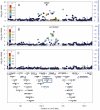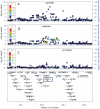Genome-wide association study identifies chromosome 10q24.32 variants associated with arsenic metabolism and toxicity phenotypes in Bangladesh
- PMID: 22383894
- PMCID: PMC3285587
- DOI: 10.1371/journal.pgen.1002522
Genome-wide association study identifies chromosome 10q24.32 variants associated with arsenic metabolism and toxicity phenotypes in Bangladesh
Abstract
Arsenic contamination of drinking water is a major public health issue in many countries, increasing risk for a wide array of diseases, including cancer. There is inter-individual variation in arsenic metabolism efficiency and susceptibility to arsenic toxicity; however, the basis of this variation is not well understood. Here, we have performed the first genome-wide association study (GWAS) of arsenic-related metabolism and toxicity phenotypes to improve our understanding of the mechanisms by which arsenic affects health. Using data on urinary arsenic metabolite concentrations and approximately 300,000 genome-wide single nucleotide polymorphisms (SNPs) for 1,313 arsenic-exposed Bangladeshi individuals, we identified genome-wide significant association signals (P<5×10(-8)) for percentages of both monomethylarsonic acid (MMA) and dimethylarsinic acid (DMA) near the AS3MT gene (arsenite methyltransferase; 10q24.32), with five genetic variants showing independent associations. In a follow-up analysis of 1,085 individuals with arsenic-induced premalignant skin lesions (the classical sign of arsenic toxicity) and 1,794 controls, we show that one of these five variants (rs9527) is also associated with skin lesion risk (P = 0.0005). Using a subset of individuals with prospectively measured arsenic (n = 769), we show that rs9527 interacts with arsenic to influence incident skin lesion risk (P = 0.01). Expression quantitative trait locus (eQTL) analyses of genome-wide expression data from 950 individual's lymphocyte RNA suggest that several of our lead SNPs represent cis-eQTLs for AS3MT (P = 10(-12)) and neighboring gene C10orf32 (P = 10(-44)), which are involved in C10orf32-AS3MT read-through transcription. This is the largest and most comprehensive genomic investigation of arsenic metabolism and toxicity to date, the only GWAS of any arsenic-related trait, and the first study to implicate 10q24.32 variants in both arsenic metabolism and arsenical skin lesion risk. The observed patterns of associations suggest that MMA% and DMA% have distinct genetic determinants and support the hypothesis that DMA is the less toxic of these two methylated arsenic species. These results have potential translational implications for the prevention and treatment of arsenic-associated toxicities worldwide.
Conflict of interest statement
The authors have declared that no competing interests exist.
Figures



Similar articles
-
A missense variant in FTCD is associated with arsenic metabolism and toxicity phenotypes in Bangladesh.PLoS Genet. 2019 Mar 20;15(3):e1007984. doi: 10.1371/journal.pgen.1007984. eCollection 2019 Mar. PLoS Genet. 2019. PMID: 30893314 Free PMC article.
-
Arsenic metabolism efficiency has a causal role in arsenic toxicity: Mendelian randomization and gene-environment interaction.Int J Epidemiol. 2013 Dec;42(6):1862-71. doi: 10.1093/ije/dyt182. Int J Epidemiol. 2013. PMID: 24536095 Free PMC article.
-
The Genetic Architecture of Arsenic Metabolism Efficiency:A SNP-Based Heritability Study of Bangladeshi Adults.Environ Health Perspect. 2015 Oct;123(10):985-92. doi: 10.1289/ehp.1408909. Epub 2015 Mar 13. Environ Health Perspect. 2015. PMID: 25768001 Free PMC article.
-
[Relationship between Arsenic (+3 Oxidation State) Methyltransferase Genetic Polymorphisms and Methylation Capacity of Inorganic Arsenic].Nihon Eiseigaku Zasshi. 2015;70(3):186-96. doi: 10.1265/jjh.70.186. Nihon Eiseigaku Zasshi. 2015. PMID: 26411936 Review. Japanese.
-
Arsenic Methyltransferase and Methylation of Inorganic Arsenic.Biomolecules. 2020 Sep 22;10(9):1351. doi: 10.3390/biom10091351. Biomolecules. 2020. PMID: 32971865 Free PMC article. Review.
Cited by
-
Heritability and preliminary genome-wide linkage analysis of arsenic metabolites in urine.Environ Health Perspect. 2013 Mar;121(3):345-51. doi: 10.1289/ehp.1205305. Epub 2013 Jan 15. Environ Health Perspect. 2013. PMID: 23322787 Free PMC article.
-
Rare, Protein-Altering Variants in AS3MT and Arsenic Metabolism Efficiency: A Multi-Population Association Study.Environ Health Perspect. 2021 Apr;129(4):47007. doi: 10.1289/EHP8152. Epub 2021 Apr 7. Environ Health Perspect. 2021. PMID: 33826413 Free PMC article.
-
Sequencing-based fine-mapping and in silico functional characterization of the 10q24.32 arsenic metabolism efficiency locus across multiple arsenic-exposed populations.PLoS Genet. 2023 Jan 20;19(1):e1010588. doi: 10.1371/journal.pgen.1010588. eCollection 2023 Jan. PLoS Genet. 2023. PMID: 36668670 Free PMC article.
-
Toxicogenetics: in search of host susceptibility to environmental toxicants.Front Genet. 2014 Sep 22;5:327. doi: 10.3389/fgene.2014.00327. eCollection 2014. Front Genet. 2014. PMID: 25295052 Free PMC article. Review.
-
A missense variant in FTCD is associated with arsenic metabolism and toxicity phenotypes in Bangladesh.PLoS Genet. 2019 Mar 20;15(3):e1007984. doi: 10.1371/journal.pgen.1007984. eCollection 2019 Mar. PLoS Genet. 2019. PMID: 30893314 Free PMC article.
References
-
- United States Environmental Protection Agency. Fact Sheet: drinking water standard for arsenic. 2009. EPI815-R-00-015. www.epa.gov/safewater/arsenic/regulations_factsheet.html.
-
- Celik I, Gallicchio L, Boyd K, Lam TK, Matanoski G, et al. Arsenic in drinking water and lung cancer: a systematic review. Environ Res. 2008;108:48–55. - PubMed
-
- Mink PJ, Alexander DD, Barraj LM, Kelsh MA, Tsuji JS. Low-level arsenic exposure in drinking water and bladder cancer: a review and meta-analysis. Regul Toxicol Pharmacol. 2008;52:299–310. - PubMed
Publication types
MeSH terms
Substances
Grants and funding
LinkOut - more resources
Full Text Sources
Medical

